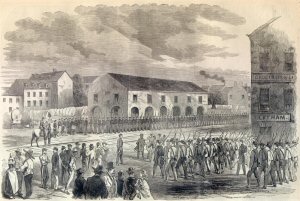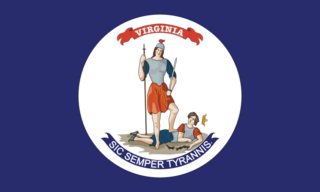
The 1st Minnesota Infantry Regiment was the very first group of volunteers the Union received in response to the South's assault of Fort Sumter at the beginning of the United States Civil War. Minnesota's Governor Alexander Ramsey offered 1000 men to Lincoln immediately upon learning of the attack on the fort. He just happened to be in Washington when the news broke. Those men volunteered for a five-year commitment (1861–64) which was much longer than other states. During combat actions, the 1st Minnesota sustained substantial casualties at the battles of First Bull Run (20%) and Antietam (28%) and a staggering 82% at the Battle of Gettysburg, where the regiment's most famous actions occurred on the second day of the battle.

The American Civil War saw cavalry tactics move largely away from the offensive towards the defensive, with the emphasis on screening, raiding, and reconnaissance. Development of the rifled musket had also rendered the cavalry charge both impractical and detrimental.
The 14th Indiana Infantry Regiment, later referred to as the Gallant Fourteenth, was an infantry regiment and part of the Union Army's celebrated "Gibraltar Brigade" of the Army of the Potomac during the American Civil War. Organized in May 1861 at Camp Vigo, near Terre Haute, Indiana, it was the state's first regiment organized for three years of service. The 14th Indiana served in major campaigns and battles in the Eastern Theater, mostly in West Virginia, Virginia, Pennsylvania, and Maryland. During its three years of service, the regiment had a total of 222 casualties.

The Texas Brigade was an infantry formation of the Confederate Army that distinguished itself in the American Civil War. Along with the Stonewall Brigade, they were considered the Confederate Army's shock troops. It fought in every major battle of the Eastern Theater except Chancellorsville.
The 14th West Virginia Infantry Regiment was an infantry regiment that served in the Union Army during the American Civil War.

The city of Winchester, Virginia, and the surrounding area, were the site of numerous battles during the American Civil War, as contending armies strove to control the lower Shenandoah Valley. Winchester changed hands more often than any other Confederate city.

The 26th North Carolina Infantry Regiment was an infantry regiment of the Confederate States Army during the American Civil War. The regiment was composed of ten companies that came from various counties across North Carolina and Virginia. It is famous for being the regiment with the largest number of casualties on both sides during the war.
The 1st Delaware Infantry Regiment, later known as the 1st Delaware Veteran Infantry Regiment was a United States volunteer infantry regiment raised for Union Army service in the American Civil War. Part of the II Corps it served in the Eastern Theater of the American Civil War.

The 3rd Arkansas Infantry Regiment was a regiment of the Confederate States Army during the American Civil War, and the most celebrated unit from the state. Formed and initially commanded by Colonel Albert Rust, and later falling under the command of Colonel Van. H. Manning, the regiment was part of the Army of Northern Virginia, serving under General Robert E. Lee. The 3rd Arkansas Infantry Regiment served for the duration of the war, from the late months of 1861, through to its surrender at Appomattox Court House in 1865. It was the only regiment from the state of Arkansas to serve the entire war in the Eastern Theater, where most of the major Civil War battles were fought. It was also the only Arkansas regiment to initially sign up for the duration of the Civil War, with all other regiments from the state signing on for a one-year enlistment.

The 8th Virginia Infantry Regiment was a Confederate infantry regiment raised by Colonel Eppa Hunton in Leesburg, Virginia on May 8, 1861. The unit comprised six companies from Loudoun, two companies from Fauquier, one company from Fairfax and one company from Prince William. Initial regimental officers included: Lt. Colonel Charles B. Tebbs, Major Norborne Berkeley, John M. Orr - Quartermaster, Dr. Richard H. Edwards - Surgeon, Charles F. Linthicum - Chaplain. After Eppa Hunton's promotion to brigadier general in August 1863, in part based on his valor during the Battle of Gettysburg, particularly during Pickett's Charge, Norborne Berkeley was promoted to command the 8th Virginia, and his brother Edmund became the Lieut. Colonel, his brother William Berkeley, Major, and Charles Berkeley became the senior Captain of what then became known as the "Berkeley Regiment." Nonetheless, Norborne, William and Charles Berkeley were all in Union prisoner of war camps and their brother Edmund still recovering from his Gettysburg wound on August 9.
The 24th Georgia Infantry Regiment was an infantry regiment in the Confederate States Army during the American Civil War. The regiment was part of Thomas Cobb's brigade at the Battle of Fredericksburg.

The 25th Virginia Infantry Regiment was an infantry regiment raised in Virginia for service in the Confederate States Army during the American Civil War. It fought mostly with the Army of the Northwest and Army of Northern Virginia. Its soldiers saw action from the battle of Philippi until the Appomattox.

The 42nd Virginia Infantry Regiment was an infantry regiment raised in Virginia for service in the Confederate States Army during the American Civil War. It fought mostly with the Army of Northern Virginia.

The 61st Virginia Infantry Regiment was an infantry regiment raised in Virginia for service in the Confederate States Army during the American Civil War. It fought mostly with the Army of Northern Virginia. The core of what would become the 61st Virginia was organized in Norfolk, Virginia in summer 1861 as the 7th Battalion, Virginia Reserves with eight companies. It served as heavy artillery in the Portsmouth and Norfolk area. However, when these cities were evacuated, the unit was transferred to the infantry and merged into the 61st Regiment being formed in Petersburg, Virginia in October 1862. Lieutenant Colonel Samuel M. Wilson was placed in command. The men of the 61st Virginia were from Portsmouth, and the counties of Norfolk, Isle of Wight, and Greensville. It was assigned to General Mahone's Brigade and which became General Weisinger's Brigade, Army of Northern Virginia upon General Mahone's promotion to Division Commander.

The 2nd Virginia Cavalry Regiment was a cavalry regiment raised in Virginia for service in the Confederate States Army during the American Civil War. It fought mostly with the Army of Northern Virginia.

The 10th Virginia Cavalry Regiment was a cavalry regiment raised in Virginia for service in the Confederate States Army during the American Civil War. It fought mostly with the Army of Northern Virginia.
The 25th Ohio Infantry Regiment was an infantry regiment in the Union Army during the American Civil War.
The following list is a bibliography of American Civil War Confederate military unit histories and are generally available through inter-library loan. More details on each book are available at Worldcat. For an overall national view, see Bibliography of the American Civil War. For histories of the Union, see Bibliography of American Civil War Union military unit histories. For a guide to web sources see: Carter, Alice E.; Jensen, Richard. The Civil War on the Web: A Guide to the Very Best Sites—Completely Revised and Updated (2003).
The 4th New Jersey Infantry Regiment was an infantry regiment in the Union Army during the American Civil War.

The 28th Virginia battle flag is a Confederate battle flag that belonged to the 28th Virginia Infantry Regiment. Captured by the 1st Minnesota Infantry Regiment at the Battle of Gettysburg, the flag was brought to Minnesota and exhibited at the state's capitol for several years before passing into the permanent collection of the Minnesota Historical Society after 1896 where it has remained since. Although various groups in Virginia have requested that the flag be returned, beginning as early as 1960, Minnesota has repeatedly declined to return it.













